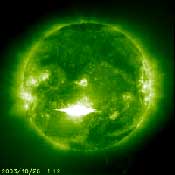 |
Update on the Solar Storm - Tuesday/Wednesday
Solar Punch
  |
|
The third most-powerful solar flare ever observed
in X-ray wavelengths erupted from Sunspot 486 early
October 28, 2003, at approximately 6 a.m. Eastern
Standard Time. A coronal mass ejection (CME) directed
almost straight at Earth preceded the flare, sending
electrically charged gas toward our planet, say NASA and
European Space Agency (ESA) scientists. To follow up,
the same spot released a large X11 flare Wednesday
afternoon and it too is associated with a CME.
To the left, a powerful X11 flare
that erupted Wednesday afternoon at 3:48 pm ET, seen
with the EIT instrument on SOHO. To the right, Tuesday's
record-setting X17.2 flare; both are from Sunspot 486
and Earth-directed, meaning spectacular aurora in areas
not usually lucky enough to see them. The Wednesday
flare links to a print-resolution version; the Tuesday
flare links to a movie of the explosion. Credit: NASA /
ESA |

Credit: NASA/University of
Iowa
The coronal mass ejection swept past Earth today
triggered an intense geomagnetic storm. The northern lights
were visible as far south as Arkansas, Texas and
Oklahoma.
The very active aurora was also visible to NASA
satellites that study the impacts of space weather. This image
of the aurora over the southern hemisphere was captured by the
Polar spacecraft about 3 p.m. EST. The Polar data, shown in
green, are projected on the map of the globe. (The aurora over
the northern hemisphere were not visible to the spacecraft
when these data were collected.)
Additional images
should be uplinked during the NASA-TV feed on
Thursday.
This image is generated from data collected by the
University of Iowa's Visible Imaging Investigations (VII)
Visible Imaging System (VIS) on board NASA's Polar spacecraft.
It was designed and built by the Particles and Imaging
research group from The University of Iowa. The Principal
Investigator is Dr. Louis A. Frank and the Project Scientist
and Manager is Dr. John B. Sigwarth.
X 17.2 Flare Observed

 |
EIT image of region 10486 during
X5.4 flare.
MPEG Movie
Large/Small |
Active region 10486, already under close scrutiny by
several instruments on SOHO and other satellites, as well as
numerous ground observatories, played up a spectacular show in
the morning on Tuesday 28 October 2003. An X 17.2 flare, the
second largest flare observed by SOHO, was setting off a
strong high energy proton event and a fast-moving Coronal Mass
Ejection.

High
resolution version (5.13 MB)
Back
to
Top |



